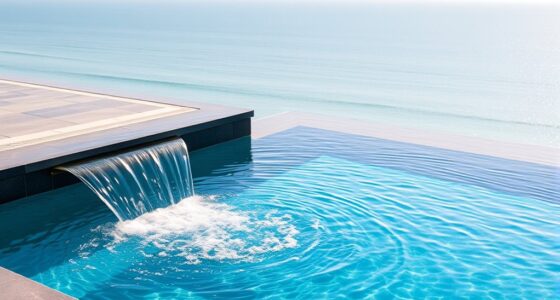To winterize your infinity pool, start by draining the water properly, guaranteeing the level stays below the skimmer and tile line. Clean out debris and balance your water chemistry, adjusting pH, alkalinity, and sanitizer levels. Next, lower the water level further and add antifreeze to safeguard plumbing. Disconnect and store equipment, then cover the pool securely with a taut cover secured by weights and straps. Finish with a final inspection to ensure everything’s in place to keep your pool protected through winter.
Key Takeaways
- Drain the pool completely, including plumbing lines, and lower water level below the skimmer and tile line.
- Clean and remove all debris, then balance water chemistry to prevent algae and corrosion during winter.
- Disconnect, clean, and store pool equipment, and blow out plumbing lines to prevent freezing damage.
- Add pool antifreeze to plumbing lines and ensure all fittings are protected with insulation.
- Cover the pool securely with a winter cover, ensuring it is tight, anchored, and free of debris for safety and protection.
Drain the Pool Properly

Before winter arrives, it is essential to drain your infinity pool properly to prevent damage from freezing water. Start by turning off the pool’s pump and heater, then disconnect all equipment. Open the drain valves to let the water flow out completely. Use a submersible pump or a sump pump if necessary to remove residual water from the basin. Confirm the water level drops below the skimmer and returns to prevent freezing pressure buildup. Check the manufacturer’s instructions for specific draining procedures, especially for the infinity edge. Be thorough—any remaining water can freeze and cause cracks or damage. Once drained, seal all valves and openings to prevent air and debris from entering during the winter months. Proper drainage safeguards your pool’s structure for the off-season. Being aware of the weight of the equipment helps ensure safe handling during the winterization process.
Clean and Remove Debris

You should start by removing any surface debris, like leaves and dirt, to keep the pool clean. Next, skim the bottom of the pool to pick up any settled debris and guarantee the area is spotless. Finally, remove any floating items, such as toys or pool accessories, to prevent them from causing issues during winter.
Clear Surface Debris
To guarantee your infinity pool looks pristine and functions properly during winterizing, start by removing surface debris such as leaves, twigs, and dirt. Use a leaf net or pool skimmer to gently scoop everything off the water’s surface. This prevents debris from sinking and decaying, which could cause staining or algae growth later. Pay special attention to corners and edges where debris tends to accumulate. Remove floating debris promptly to keep the water clear and free-flowing. If needed, wipe down the edges and any surrounding surfaces to eliminate dirt and prevent mold. Clearing surface debris not only improves water quality but also makes the winterization process smoother, ensuring your pool remains in top condition throughout the colder months. Regular maintenance and pool cleaning tips can further help in maintaining optimal water health during the off-season.
Skim Pool Bottom
After removing surface debris, focus on cleaning the pool bottom to prevent dirt and leftover particles from settling and causing staining or algae growth during winter. Use a leaf net or vacuum to sweep the pool floor thoroughly. This step guarantees no small debris remains that could decompose or promote algae. Visualize a clean, sparkling surface, free of dirt and leaves, ready for winter storage. To achieve this, you’ll want to: – Attach a vacuum head to your telescopic pole – Use a pool vacuum to systematically cover the entire bottom – Target corners and hard-to-reach spots – Rinse and check your equipment afterward. A clean bottom keeps your pool in top condition and makes opening it easier when spring arrives. Regular maintenance can also help prevent algae growth and other issues associated with winter storage.
Remove Floating Items
Have floating debris cluttering your pool surface? You need to remove any leaves, insects, or dirt before winterizing. Use a net skimmer to carefully scoop debris from the water’s surface, working systematically across the entire pool. Don’t forget to check corners and hard-to-reach spots where debris can accumulate. Removing floating items prevents stains, algae growth, and clogging of your filtration system during the off-season. After skimming, inspect the water for any remaining debris or insects and remove them manually if necessary. Clear water not only makes closing your pool easier but also helps protect the pool’s interior and equipment during the winter months. Proper water quality management during this process can also prevent issues like cloudiness or algae buildup later on. Taking these quick steps ensures your pool stays clean and ready for a smooth reopening in spring.
Balance Pool Water Chemistry

Balancing your pool water chemistry is essential to make sure it stays clean, clear, and safe throughout the winter. Proper chemical levels prevent algae growth, corrosion, and staining, protecting your pool’s surfaces and equipment. To achieve this, test your water using a reliable kit, checking pH, alkalinity, calcium hardness, and sanitizer levels. Adjust these parameters as needed:
- Add pH increaser or decreaser to maintain a stable pH between 7.2 and 7.6
- Raise alkalinity to buffer pH fluctuations
- Regulate calcium hardness to prevent scaling or etching
- Maintain sanitizer levels to inhibit bacteria and algae growth
Keeping these levels balanced ensures your pool remains in good condition during the off-season, making spring startup easier.
Lower Water Level and Add Antifreeze

To protect your infinity pool during winter, you need to lower the water level to prevent freezing damage. Next, add pool antifreeze to the plumbing lines to keep them from freezing and cracking. Finally, make sure to secure all pool equipment so it stays safe and functional through the cold months. Incorporating a water treatment system can help maintain water quality and prevent buildup during the off-season.
Drain Excess Water
Wondering how to properly drain excess water from your infinity pool? First, verify your pool’s water level is lowered below the skimmer and tile line. To do this, attach a siphon or use the built-in drain valve, allowing gravity to do the work. As the water level drops, you’ll see the surface receding, revealing the pool’s features. Next, check that the water is drained from all components, including the pump and filter lines. Picture the water flowing out, leaving the pool’s surface smooth and clear. Finally, inspect the area for any remaining water that might freeze and cause damage. Remember, a well-drained pool reduces the risk of freeze damage and ensures a safer winterization. Proper shower maintenance can also help extend the lifespan of your pool fixtures and prevent leaks.
Use Pool Antifreeze
Once you’ve lowered the water level below the skimmer and tile line, it is vital to add pool antifreeze to prevent any remaining water from freezing and damaging your plumbing. Use a siphon or a pump to introduce the antifreeze into the skimmer, jets, and any plumbing lines that may trap water. Be sure to follow the manufacturer’s instructions for the correct amount of antifreeze needed. Pour antifreeze into the skimmer and run the pump briefly to circulate it through the system. This ensures all residual water in the pipes and fittings is protected against freezing temperatures. Using antifreeze is essential in preventing cracks or burst pipes during winter freezes, especially when water can’t be entirely drained from the system.
Secure Pool Equipment
As winter approaches, you should begin by lowering the water level below the skimmer and tile line to prevent damage from freezing. Once done, focus on securing your pool equipment. Remove and store any removable components like skimmer baskets and return jets. Cover or disconnect pumps, filters, and heaters to shield them from the cold. Drain and blow out the plumbing lines to prevent ice expansion. Make certain all equipment is dry and stored in a protected area if possible. Visualize the process with these steps:
- Removing and storing skimmer baskets
- Covering or disconnecting pumps and filters
- Draining and blowing out plumbing lines
- Storing equipment in a safe, dry place
Proper winterization helps prevent costly damage and ensures your pool remains in good condition for the next season.
Protect Pool Equipment

How can you guarantee your pool equipment survives the winter? Start by disconnecting and cleaning all equipment. Drain filters, pumps, and heaters to prevent freezing damage. Store small parts indoors, and cover exposed fittings with insulation. Regularly inspect for leaks or cracks before winter hits. To keep track, use this quick reference:
| Equipment | Action | Storage Tips |
|---|---|---|
| Pump | Disconnect & clean | Indoor or covered area |
| Filter | Drain & store | Keep dry and protected |
| Heater | Flush & store | Indoors if possible |
Additionally, consulting proper maintenance techniques can help ensure longevity of your equipment. Protecting your equipment guarantees it stays in top shape, ready for the season ahead, and saves you costly repairs later.
Cover the Pool Securely

Covering your pool securely is essential to prevent debris, keep the cold out, and protect it from winter damage. A tight cover keeps leaves, dirt, and critters from entering, reducing cleanup in spring. To guarantee a proper fit, select a cover designed for your pool’s size and shape. Secure the edges with weights or anchors, so it doesn’t shift or blow away. Envision a sturdy cover stretched tightly over the water, with the edges tucked under the pool’s rim. Picture weights or water bags holding it firmly in place, and safety straps securing it against wind. Imagine a seamless barrier that shields your pool from snow, ice, and debris, preserving its condition through the cold months. Proper coverage is your first step toward a smooth start-up next season.
Perform a Final Inspection and Maintenance Check

Once you’ve securely covered your infinity pool, the next step is to perform a thorough inspection and maintenance check. Walk around the pool and ensure the cover is tight and free of tears or debris. Check the area for any signs of pests or water leaks. Inspect the pool equipment, like pumps and filters, for any damage or corrosion. Verify that all drain plugs and valves are properly sealed to prevent water entry. Clear any debris from skimmers or jets that might have accumulated. Test the pool’s electrical components to confirm they’re functioning correctly. If you notice any issues, address them immediately to prevent problems during winter. Conducting a proper maintenance check helps extend the lifespan of your pool equipment and ensures everything is in optimal condition for the next season. This final check guarantees your pool remains protected and ready for winter storage.
Frequently Asked Questions
How Often Should I Check My Infinity Pool During Winter?
You should check your infinity pool at least once a week during winter to guarantee everything remains in good condition. Look for any debris, ice buildup, or leaks, and monitor the water level. Regular checks help you catch issues early, preventing damage caused by freezing temperatures. If you notice any problems, address them promptly to keep your pool protected and ready for use when spring arrives.
What Safety Precautions Are Necessary When Winterizing the Pool?
You need to prioritize safety when winterizing your infinity pool; always wear gloves and safety goggles to protect yourself from chemicals and debris. Keep children and pets away from the area to prevent accidents. Make certain all equipment is turned off and unplugged, and handle pool chemicals carefully to avoid spills or fumes. Double-check that the area is well-ventilated and free of hazards before starting, making safety your top priority throughout the process.
Can I Leave the Pool Cover on Year-Round?
You can leave the pool cover on year-round, but it’s not always advised. If you live in a climate with harsh winters, leaving the cover on protects your pool from debris, dirt, and harsh weather. However, you should remove it periodically to inspect for mold, algae, or damage, and to guarantee proper drainage. Regular maintenance helps prevent issues and extends the life of your cover and pool equipment.
Are There Specific Antifreeze Types Recommended for Infinity Pools?
Yes, you should use a non-toxic, propylene glycol-based antifreeze specifically designed for pools. Avoid automotive antifreeze, as it contains toxic chemicals harmful to your pool and environment. Check with your pool supplier for the recommended brand and type, ensuring it’s compatible with your infinity pool’s plumbing and equipment. Proper antifreeze prevents freezing damage, protecting your investment and keeping your pool in good shape for spring.
How Do I Prevent Algae Growth During the Winter Months?
You can’t let algae have the field day, so take action now. Regularly run your pool filter, even during the cold months, to keep water moving. Apply a winter algaecide and balance your chemicals, especially chlorine or bromine, to prevent growth. Cover your pool with a sturdy, winter-safe cover to limit sunlight exposure and debris. Staying vigilant keeps algae at bay, so your pool remains pristine when spring blooms.
Conclusion
Now that you’ve wrapped up your winterizing process, your pool is like a well-prepared ship ready to weather the storm. By following these steps, you’ve created a fortress against the cold, protecting your investment and making certain it’s ready to shine again when spring arrives. Think of your efforts as planting a seed—care now guarantees a vibrant, sparkling oasis comes back to life in warmer days. You’ve set the stage for a seamless, stress-free reopening next season.









